CONTEXT: Drum circles have been part of healing rituals in many cultures throughout the world since antiquity. Although drum circles are gaining increased interest as a complementary therapeutic strategy in the traditional medical arena, limited scientific data documenting biological benefits associated with percussion activities exist.
OBJECTIVE: To determine the role of group-drumming music therapy as a composite activity with potential for alteration of stress-related hormones and enhancement of specific immunologic measures associated with natural killer cell activity and cell-mediated immunity.
DESIGN: A single trial experimental intervention with control groups.
SETTING: The Mind-Body Wellness Center, an outpatient medical facility in Meadville, Pa.
PARTICIPANTS: A total of 111 age- and sex-matched volunteer subjects (55 men and 56 women, with a mean age of 30.4 years) were recruited.
INTERVENTION: Six preliminary supervised groups were studied using various control and experimental paradigms designed to separate drumming components for the ultimate determination of a single experimental model, including 2 control groups (resting and listening) as well as 4 group-drumming experimental models (basic, impact, shamanic, and composite). The composite drumming group using a music therapy protocol was selected based on preliminary statistical analysis, which demonstrated immune modulation in a direction opposite to that expected with the classical stress response. The final experimental design included the original composite drumming group plus 50 additional age- and sex-matched volunteer subjects who were randomly assigned to participate in group drumming or control sessions.
MAIN OUTCOME MEASURES: Pre- and postintervention measurements of plasma cortisol, plasma dehydroepiandrosterone, plasma dehydroepiandrosterone-to-cortisol ratio, natural killer cell activity, lymphokine-activated killer cell activity, plasma interleukin-2, plasma interferon-gamma, the Beck Anxiety Inventory, and the Beck Depression Inventory II.
RESULTS: Group drumming resulted in increased dehydroepiandrosterone-to-cortisol ratios, increased natural killer cell activity, and increased lymphokine-activated killer cell activity without alteration in plasma interleukin 2 or interferon-gamma, or in the Beck Anxiety Inventory and the Beck Depression Inventory II.
CONCLUSIONS: Drumming is a complex composite intervention with the potential to modulate specific neuroendocrine and neuroimmune parameters in a direction opposite to that expected with the classic stress response.
 Drumming: Various indigenous cultures use the drum to create a sense of unity with others especially during recreational events. The drum also helps in prayers and meditations.
Drumming: Various indigenous cultures use the drum to create a sense of unity with others especially during recreational events. The drum also helps in prayers and meditations.